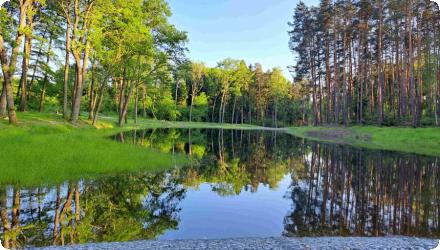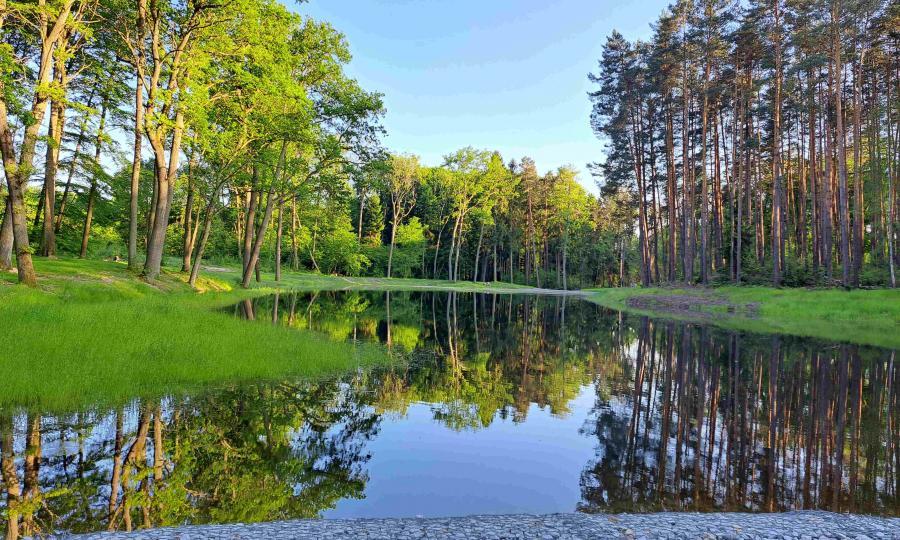Last update
2025
Summary
The Polish governmental agreement on water retention in small‑scale infrastructures was signed in 1995 to improve the structure of the water balance of small catchments by 2015. Regional authorities (voivodships) elaborated retention development programmes, largely completed by 1996. The plan focused on small water bodies - ponds - anticipating retention gains of approximately 860 million m³ across 4 789 reservoirs.
Since then, however, new initiatives and practices have emerged. The State Forests (Lasy Państwowe) have been implementing and consolidating small‑scale retention works in lowland forest ecosystems since the mid‑1990s, under EU‑funded programs. By 2014, this effort increased landscape storage from about 8.38 million m³ (2007) to roughly 31 million m³, enhancing biodiversity via wetland restoration and management.
In parallel, a growing number of micro‑retention (rainwater harvesting) schemes have been observed in rural and urban contexts: individual rainwater systems for households, small reservoirs, and green‑blue infrastructure, used to counter drought, reduce stormwater runoff, and support local water availability.
However, the national “My Water” subsidy programme (2020–2024), which supported residential micro‑retention installations, is not being continued in 2025. Instead, many municipalities now offer their own incentives and grants - for example in Goleszów, Gostyń, Warsaw, and Lubliniec - supporting rainwater retention systems with varying subsidy levels.
Since then, however, new initiatives and practices have emerged. The State Forests (Lasy Państwowe) have been implementing and consolidating small‑scale retention works in lowland forest ecosystems since the mid‑1990s, under EU‑funded programs. By 2014, this effort increased landscape storage from about 8.38 million m³ (2007) to roughly 31 million m³, enhancing biodiversity via wetland restoration and management.
In parallel, a growing number of micro‑retention (rainwater harvesting) schemes have been observed in rural and urban contexts: individual rainwater systems for households, small reservoirs, and green‑blue infrastructure, used to counter drought, reduce stormwater runoff, and support local water availability.
However, the national “My Water” subsidy programme (2020–2024), which supported residential micro‑retention installations, is not being continued in 2025. Instead, many municipalities now offer their own incentives and grants - for example in Goleszów, Gostyń, Warsaw, and Lubliniec - supporting rainwater retention systems with varying subsidy levels.
Position
Latitude
52.232
Longitude
21.008
Project
NWRM
National Id
Poland_01
Installation date
1997-2015
Implementation Status
Contact
Kristina Veidemane, BEF
Transboundary
0
Photo gallery
Project's objectives
Improve water balance in small catchments by 2015.
Build or modernize 4,789 small reservoirs.
Reach a total retention capacity of 860 million m³.
Build or modernize 4,789 small reservoirs.
Reach a total retention capacity of 860 million m³.
Involved Partners
| Authority type | Authority name | Role | Comments |
|---|---|---|---|
Climate zone
cool temperate dry
Temperature
7 °C
Annual rainfall range
300 - 600 mm
Elevation range
0- 500 m
Water bodies: Ecological Status
Depends on the site
Water bodies: Chemical Status
Depends on the site
Project scale
Large
Project scale specification
The programme was national in scope, initiated through a governmental agreement in 1995, involving all voivodships of Poland. The objective was to plan and implement thousands of retention reservoirs (target: 4,789) to collectively store 860 million m³ across rural areas. These efforts contribute to national water management and climate adaptation policy.
Performance timescale
> 20 years
Project area
20
Lifespan
Over 20 years
− stop degradation of the existing and start the construction of new reclamation facilities, particularly those intended for irrigation, water lifting and hampering rapid water outflow,
− consider the possibility of flood control,
− facilitate the reduction of surface runoff through planting forests and midfield woods,
− locate the objects in places appropriate for increasing the recharge of aquifers, − consider the motions of local communities (communes, farmers), − be agreed on with regional boards of water management.
− consider the possibility of flood control,
− facilitate the reduction of surface runoff through planting forests and midfield woods,
− locate the objects in places appropriate for increasing the recharge of aquifers, − consider the motions of local communities (communes, farmers), − be agreed on with regional boards of water management.
Design capacity description
Mean volumes of retained water per one object in 1997-2007 are differentiated for particular elements of small retention. Mean unit volume of constructed reservoirs and ponds were from c. 20 up to 200 thousand m3.
The main reason was low financial inputs but also complex formal procedures before realisation of an object due to legal restrictions associated mainly with environmental protection.
Costs investment information
393 million zloti in the period of 1997-2007; unit costs were between 3.63 to 19.60 zloti per m3 of a water reservoir.
Financing authorities
Type of funding
Sub-national funds
Comments
Voivodship funds for environmental protection and water management, and their own budget
Type of funding
National funds
Comments
National Fund for Environmental Protection and Water Management
(NFEPWM),
(NFEPWM),
Type of funding
Local funds
Comments
budget of communes
Type of funding
National funds
Comments
Fund for the Protection of Agricultural Lands (FPAL)
Type of funding
National funds
Compensations
0
Policy context
Since the beginning of the 1990th agriculture have encountered climate changes which manifested themselves by dry years, less snowy winters and rapid floods even in small rivers. It posed periodical problems in water management because Poland is a country of relatively small water resources and their variable spatial distribution. Actions were undertaken to slow down or hamper water outflow
from natural and artificial running waters, to store waters in small reservoirs and terrain depressions and to increase the retention of water in soils and aquifers. In Poland such actions are termed †œsmall retention† as opposed to water retention in large reservoirs for power production, flood control, drinking water intakes for large cities etc.
from natural and artificial running waters, to store waters in small reservoirs and terrain depressions and to increase the retention of water in soils and aquifers. In Poland such actions are termed †œsmall retention† as opposed to water retention in large reservoirs for power production, flood control, drinking water intakes for large cities etc.
Land ownership
In forested areas, land is publicly owned and managed by State Forests (Lasy Państwowe). In rural/agricultural areas, land is often privately owned, mainly by farmers or rural households.
Community involvment
No
Design consultation activity
| Activity stage | Name | Key issues | Comments |
|---|
Policy target
| Target purpose |
|---|
|
Increase Water Storage
|
|
Groundwater Recharge
|
|
Runoff control
|
Policy pressure
| Pressure directive | Relevant pressure |
|---|---|
|
WFD identified pressure
|
3.1 Abstraction - Agriculture
|
|
Floods Directive identified pressure
|
Natural Exceedence
|
|
WFD identified pressure
|
4.1.2 Physical alteration of channel/bed/riparian area/shore of water body for agriculture
|
Policy impact
| Impact directive | Relevant impact |
|---|---|
|
WFD identified impact
|
Altered habitats due to hydrological changes
|
|
WFD identified impact
|
Waterbody status
|
Requirement directive
| Requirement directive | Specification |
|---|
Requirement directive remarks
The programme was not intended to support the WFD as it was launched before the WFD was adopted. However, its implementation supports integrated water management.
Policy challenges requirements
The small retention measures including reservoirs or ponds aimed at addressing the challenge of water balance in small catchments in Poland.
Contractual arrangements
1
| Arrangement type | Responsibility | Role | Name | Comments |
|---|---|---|---|---|
|
Institutional arrangement
|
Agreement between between the Ministry of Agriculture and Food Economy and the Minister of Environmental Protection, Natural Resources and Forestry of Poland on cooperation in the field of the development of small water retention
|
Part of wider plan
1
Wider plan type
| Wider plan type | Wider plan focus | Name | Comments |
|---|
Monitoring and maintenance are conducted locally by project owners (e.g. voivodship governments, communes, State Forests, or private beneficiaries) depending on the type of small retention project.
In State Forests projects, monitoring focuses on functionality of retention structures, state of vegetation, and biodiversity indicators.
Maintenance
In recent municipal projects, maintenance is integrated in the design-build contract, and focuses on sediment removal, vegetation management, and structural inspections of small reservoirs.
Water provision to deliver water services to the economy both for drinking and non-drinking purposes. Amenities (associated to habitat protection): fish and plants, tourism, recreation, and others.
Hydrological effects
Raised groundwater; improved retention; reduced flood peaks
Water quality overall improvements
Positive impact-WQ improvement
Information on Water quality overall improvements
Significant reduction in nitrogen pollution downstream from small reservoirs. Water quality improvements were observed at the Jagodno Reservoir: reductions of roughly 43.4% in total nitrogen and 58.2% in nitrate nitrogen loads downstream
1
Enhanced forest moisture and habitat; increased beetle, bird, and fish diversity; minor habitat loss and invasive species noted
Key lessons
The Polish governmental agreement on water retention in small scale infrastructures was signed in 1995 to improve the structure of the water balance of small catchments by 2015. The regional authorities (voivodships) had to elaborate the programme of small retention development which was accomplished in 1996 for most of the regions. The planned increase in the volume of retention waters was based mainly on small water bodies (ponds), which was predicted to get the retention of the order of 860 million m3 (4789 reservoirs). However, by 2007, the achieved capacity of reservoirs was 9% of planned. The main reason was low financial inputs but also complex formal procedures before realisation of an object due to legal restrictions associated mainly with environmental protection.
Success factor(s)
| Success factor type | Success factor role | Comments | Order |
|---|---|---|---|
|
Other
|
main factor
|
Public ownership of land (in forest areas) : Implementation was easier and faster in areas owned and managed by State Forests (Lasy Państwowe), avoiding complex negotiations with private landowners. |
|
|
Attitude of relevant stakeholders
|
main factor
|
Local engagement and flexibility |
|
|
Conducted assessments (incl. economic)
|
secondary factor
|
Long-term monitoring and maintenance by land managers. In forests, local forest units are directly responsible for maintenance, using existing structures and staff. In residential schemes (e.g. “My Water”), users commit to maintaining installations, ensuring function over time. |
Driver
| Driver type | Driver role | Comments | Order |
|---|---|---|---|
|
Organisation committed to it
|
main driver
|
The Polish Government in 1995 decided to launch the programme of small water retention in rural areas
|
1
|
Flexibility adaptability
The small reservoirs can be and are constructed in different ways and for various purposes - recreational, floristic and faunistic conservation sites, swimming pools, water quality protection (constructed wetlands) and infiltration reservoirs
Transferability
The small retention programme is national wide. Initially having focus on agriculture areas, but since 2007 the activities are also implemented in forest areas of Poland. Installation of ponds or small reservoirs is also taking place in nature protected areas where wet habitats play important role.
English

